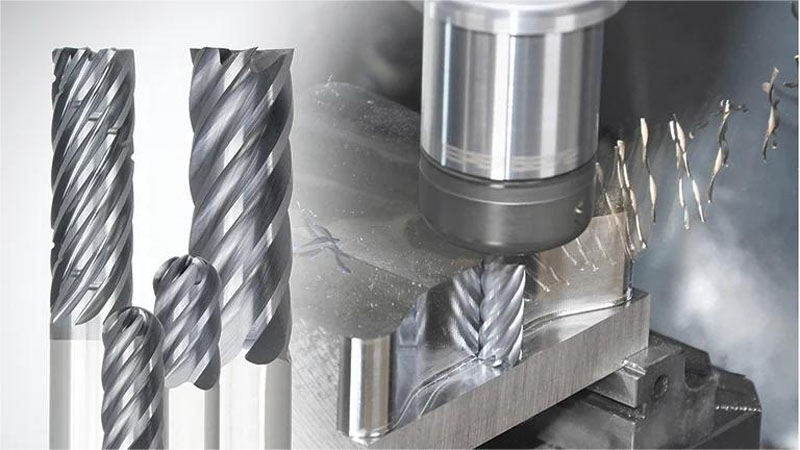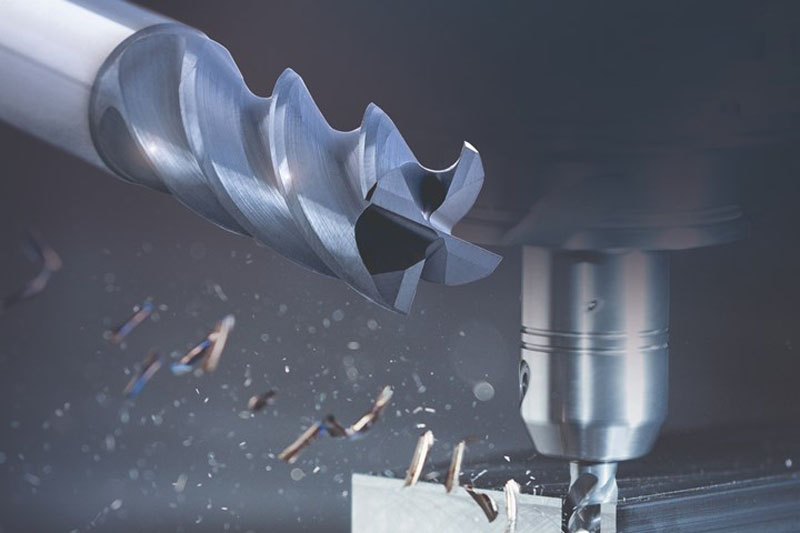Industry news
How to Choose the Correct Carbide Milling Cutter?
Milling cutters made of carbide are called carbide milling cutters. Cemented carbide is a powder metallurgical product made of carbide micron-sized powder of high-hardness refractory metal as the main component; cobalt or nickel as the binder, and sintered in a vacuum furnace or hydrogen reduction furnace.
Carbide milling cutters are mainly divided into: solid carbide milling cutters, carbide straight shank groove milling cutters, carbide saw blade milling cutters, carbide end mills and carbide ball end milling cutters, etc.
Frist. Uses of carbide milling cutters:
Carbide milling cutters are generally used in CNC machining centers and CNC engraving machines. It can also be installed on an ordinary milling machine to process some relatively hard and uncomplicated heat treatment materials. details as follows:
1. Carbide angle milling cutter: used for milling grooves at a certain angle. There are two types of single-angle and double-angle milling cutters.
2. Carbide face milling cutter: used for processing flat surfaces on vertical milling machines, end milling machines or gantry milling machines. There are cutter teeth on the end face and circumference, and there are also coarse teeth and fine teeth. There are three types of structures: integral type, toothed type and indexable type.
3. Carbide three-sided edge milling cutter: used to process various grooves and step surfaces. It has cutter teeth on both sides and the circumference.
4. Carbide end mill: used for processing grooves and step surfaces. The cutter teeth are on the circumference and end face, and cannot feed in the axial direction during work. When the end mill has end teeth that pass through the center, it can feed axially.
5. Carbide cylindrical milling cutter: used for processing flat surfaces on horizontal milling machines. The teeth are distributed on the circumference of the milling cutter. According to the tooth shape, they can be divided into two types: straight teeth and spiral teeth. According to the number of teeth, it can be divided into two types: coarse teeth and fine teeth. The spiral-tooth coarse tooth milling cutter has a small number of teeth, so the cutter teeth have high strength and a large chip space, so it is suitable for rough machining; the fine-tooth milling cutter is suitable for finishing.

Second. Milling method of carbide milling cutter
There are mainly two milling methods for carbide milling cutters relative to the feed direction of the workpiece and the rotation direction of the milling cutter:
1. Down milling. The rotation direction of the milling cutter is the same as the feed direction of cutting. When cutting starts, the milling cutter bites the workpiece and cuts off the final chips.
2. Counter milling. The rotation direction of the milling cutter is opposite to the cutting feed direction. The milling cutter must slide on the workpiece for a period of time before starting to cut. It starts with the cutting thickness of zero and reaches the maximum cutting thickness by the end of the cutting.
During down milling, the cutting force presses the workpiece toward the workbench; during uphill milling, the cutting force forces the workpiece away from the workbench. Since the cutting effect of down milling is the best, down milling is usually chosen. Only when the machine tool has thread clearance problems or problems that cannot be solved by down milling, up milling can be considered.
Third. Carbide milling cutter maintenance
When the axis line of the carbide milling cutter coincides with or is close to the edge line of the workpiece, the operator should do the following equipment maintenance:
1. Check the power and stiffness of the machine tool to ensure that the required diameter of the milling cutter can be used on the machine tool.
2. The overhang of the tool on the spindle should be as short as possible to reduce the impact of the milling cutter axis and the position of the workpiece on the impact load.
3. Use the correct milling cutter pitch suitable for the process to ensure that there are not too many blades engaging the workpiece at the same time to cause vibration during cutting. On the other hand, when milling narrow workpieces or milling cavities, ensure that there are enough blades. The blade meshes with the workpiece.
4. Make sure to use the feed per blade so that the correct cutting effect can be obtained when the chips are thick enough, thereby reducing wear on the tool. Indexable inserts with positive rake geometry for smooth cutting results and minimal power.
5. Select a milling cutter diameter suitable for the width of the workpiece.
6. Select the correct leading angle.
7. The milling cutter must be placed correctly.
8. Use cutting fluid only when necessary.

Fourth. Selection of carbide milling cutters
Except for end mills, some end mills and carbide as milling cutter materials for milling stainless steel, other types of milling cutters generally use high-speed steel, especially tungsten, molybdenum series and high-vanadium high-speed steel, which have good results. The durability is 1 to 2 times higher than that of W18Cr4V. Carbide grades suitable for making stainless steel milling cutters include: YG8, YW2, 813, 798, YS2T, YS30, etc.
Stainless steel has strong adhesion and weldability, and chips easily adhere to the milling cutter blade, worsening the cutting conditions; during reverse milling, the blade first slides on the hardened surface, increasing the tendency of work hardening; milling When the impact and vibration are large, the milling cutter blade is prone to chipping and wear.
Use wave-shaped edge end mills to process stainless steel pipes or thin-walled parts. The cutting is fast, the vibration is small, the chips are fragile, and the workpiece is not easily deformed. High speed milling with carbide end mills and stainless steel milling with indexable end mills can achieve good results.
When milling stainless steel, the down milling method should be used as much as possible. The asymmetric down milling method can ensure that the cutting edge is smoothly cut away from the metal. The bonding contact area of the chips is small, and they are easily thrown away under the action of high-speed centrifugal force, preventing the chips from impacting the rake face when the cutter teeth re-cut into the workpiece. The phenomenon of peeling and chipping improves the durability of the knife.

Hunan Jetvision Industrial Co.Ltd is one of the leading Tungsten carbide manufacturers and suppliers with over 20years experience of tungsten carbide products production and technology, It's a professional supplier which provide kinds of tungsten carbide products, such as carbide milling tool, cemented carbide rod blank, cemented carbide wire drawing dies, tungsten carbide seal rings, tungsten carbide plate, tungsten carbide bushing, carbide tube, tungsten carbide button, carbide mining inserts, carbide blade, tungsten carbide strip, carbide dies, carbide brazed tips, tungsten carbide no standard products, carbide studs, tungsten carbide customized components which are widely used in machinery, mining, construction, oil and drill, industrial engineering etc.
Keyword: Cemented carbide supplier, tungsten carbide manufacturer, buy cheap cemented carbide endmill, Tungsten carbide milling cutter manufacturer, carbide milling tool price list, cemented carbide milling cutter supplier, tungsten carbide endmill manufacturer, wholesales carbide endmill, cemented carbide milling tool in stock, buy solid carbide milling cutter, trusted tungsten carbide milling tool made in China, sintered carbide cutting in stock
Prev:What’s Manufacturing Process of Carbide Die?
Next:What’s the Cemented Carbide Dies?
